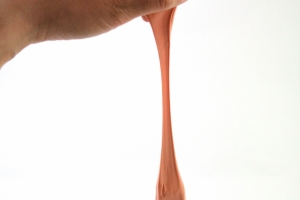
This fluorescent orange silicone-based polymer is a runny yet bouncy putty that you may have experienced as a child. It is categorised as a non-Newtonian fluid and exhibits an unusual mix of elastic and viscous properties, for when left to its own devices, it flows and puddles but hardens if a force is applied. For example, if the putty is rolled into a ball and left on a surface, within a few hours it will have flowed into a puddle shape. Alternatively, if you take the ball of putty and throw it onto the floor it will reveal its elastic properties and bounce whilst if you take the ball of putty and hit with a hammer the force will cause the putty to shatter.
This material started its life in the 1940’s as a failed rubber replacement, only later achieving success as a children’s toy. When Japan invaded Southeast Asia in 1942 and supplies of natural rubber were cut off, chemists at both Dow Corning and General Electric independently created this material using a combination of borax and silicone oil. They found that in some ways this material does mimic rubber: if you roll it into a ball and throw it against the floor it will bounce. However this material has a strange mix of elastic and liquid behaviour that is described as non-Newtonian, characterising materials like blood, ketchup and toothpaste that flow as liquids when left to their own devices but harden to become brittle solids if you apply a lot of force to them over a short period of time.
Because it flows like a liquid, silly putty was not a useful replacement for natural rubber. James Wright, the scientist who was awarded the patent for this material in 1943, sent samples of this material to scientists all over the world to try and find a use for it, but no-one was able to find a practical application. Although silly putty began its life as a failure, it finally achieved success in the 1950’s as a hugely popular toy. Since then, there have been a host of other apocryphal uses including: to secure tools and relieve stress at zero gravity on the Apollo 8 mission in 1968; for the rehabilitation of hand injuries by physical therapists; and to mimic the plasticity of plate tectonics in geological models of the earth’s crust.
Sample ID: 98 & 583
Particularities
- Selections
- Wonder Stuff
- Categories
- Polymer
- Curiosities
- Relationships
- Bouncy | Elastic | Fluorescent | Non-Newtonian | Orange | Polymer | Putty | Shear-thickening | Silicone | Viscoelastic | Viscose
Add materials you find interesting to your own selections.
Use the  button to select a material and get started.
button to select a material and get started.







